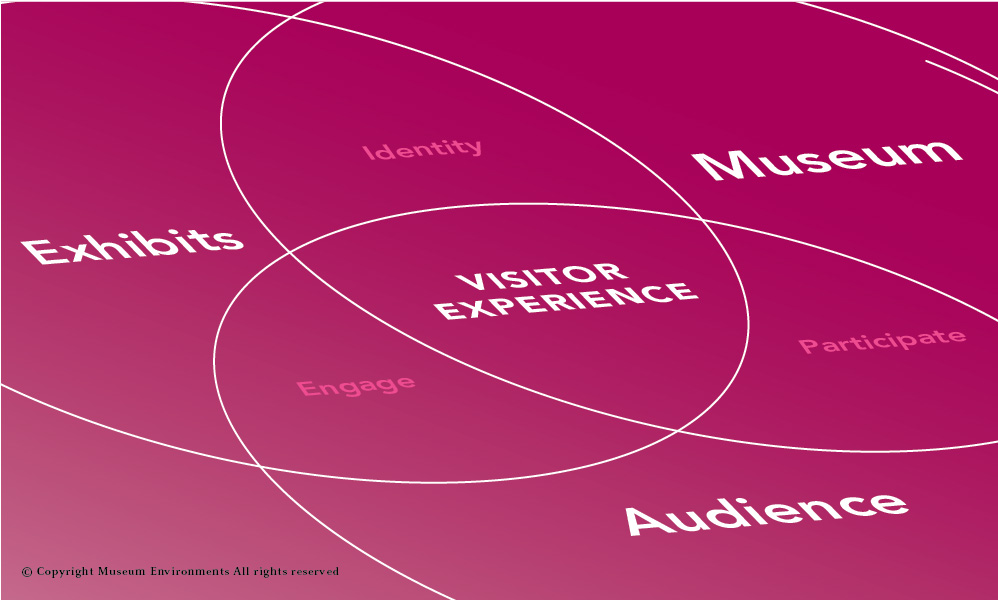Planning the Museum Experience
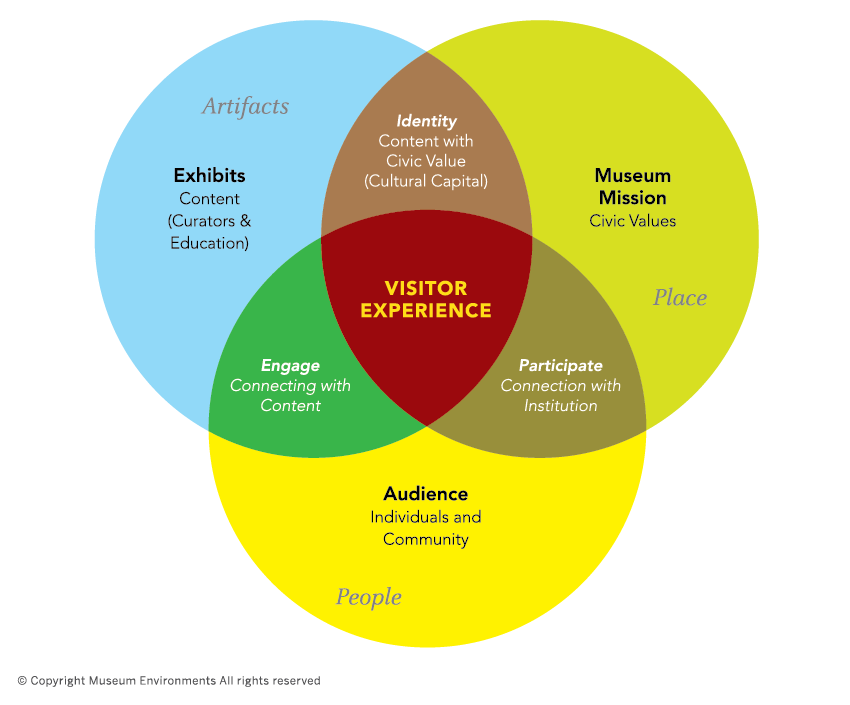
The diagram illustrates how visitor experience is the intersection of exhibits (things), visitors (people), and museum (place).
Museums have grand ambitions for their visitors. They desire nothing less than truly meaningful experience for their museum-goers. Curators and exhibit developers envision visitors earnestly engaging with the exhibits, and enthusiastically identifying with the values of our institution. In turn, museums successfully fulfill their mission as they contribute to the well-being of the community because they motivate their audience to participate in community life and live creatively. This ideal museum experience is transformative and all-encompassing. It is experiential in the fullest sense because of it’s multi-dimensional quality. The experience happens between people (audience), places (museum) and things (exhibits). A successful museum experience must cover all these spaces simultaneously. The diagram above illustrates the multi-dimensional quality of the museum experience.
At Museum Environments (ME), we have developed this Visitor Experience diagram in order to guide our design process towards a positive experiential outcome. The key to understanding the diagram is found in the overlapping areas. The overlaps are the relationships and interaction between the three parties of museum, audience and exhibits. It is there where the “experience” happens. The design of the museum-experience must take into account all these relationships with their variations and nuances in order to create a convincing and satisfying experience for the visitor.
The overlap areas in the diagram are labeled with verbs because they represent an interaction. We define these as: engagement, participation, and identity. These verbs describe the goal of what should happens between the parties. If we focus on these during the design process, we can keep our solution visitor-centered and experiential, while serving the museum mission. It is visitor centered for it focuses on the experience and the museum mission is well served because it plays a role in all times of the experience When executed comprehensively, we have added value to the museum visit.
Engagement: Content as an Experience
Curators and exhibit developers often cite that their aspiration for an exhibit is to delight, fascinate, intrigue, etc. Their desire is more than causing good impressions. They want the visitor to have a great experience. Accordingly the role of the designer is not simply to make it look good but to focus on the visitors and their experience. This provokes us to explore the content for its experiential possibilities. Is the content a story of human drama, a catalyst for the imagination, a space of wonder and many other variations on treatment. We need to look beyond themes or styles. The purpose is to find the right conversation and interaction with the audience. What is the tone of the narration? Do we have a linear path or are we allowing for the visitor to make his or her own? Are we trying to astonish the viewer or build on his or her curiosity? From this perspective we can unpack the content to reveal how it unfolds in space and time.
Case Study, El Paso Museum of History: The exhibit Neighborhoods and Shared Memories is an oral history of selected neighborhoods of El Paso, Texas. Our design focused on keeping the “first-person” narration primal to the visitor experience. Ninety percent of the floor space uses text panels with only quotes from the people of El Paso. The remaining ten percent displays the text by historians and curators. The exhibit aims to engage the visitor in conversation with the people of El Paso as verily as possible. To continue this experiential treatment in other areas of the gallery, we invited the participation of artist and craftsmen to create visuals and physical elements of the exhibits. Just as the people of El Paso are the narrators, the artists become co-creators of the exhibit. As shown in the diagram above, engagement happens at the junction between content and audience, and by literally having one part “talking” to the other, we have created an authentic voice for the exhibit.
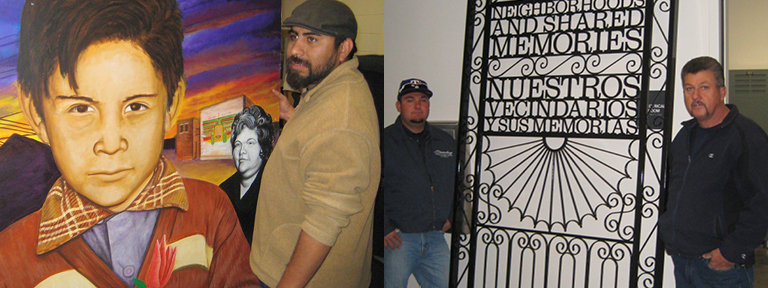
The exhibit engages the audience in a direct and honest experience thanks to the participation of artist such as Jesus “Cimi” Alvarado (left) and the Sanchez Brothers (right). The authenticity of their work surpasses any 3rd person narration in that it speaks without mediation.
Participation
: Visitor as Participant
At Museum Environments (ME) we consider the visitor a participant at all moments of the exhibit experience. It is not just when they use a digital interactive or leave behind VGC (Visitor Generated Content). The design “scaffolds” the experience in order to move the visitor from observer to participant. Initially, the visitor participates as an interpreter of content, as he or she chooses among the displays to determine their path through the exhibit. Their choices lead them to query the content, the museum’s vision, and eventually their own views. The visitor is asked to interpret their own role as interpreters and characterize their performance as perhaps citizens, artists or scientists to name a few examples. In this manner we are crafting an environment that makes the visitor-as-participant a constant. Consequently when the exhibit provides opportunities to produce VGC or have social interactions, the participants can truly be part of the subject because their role is part of the story.
The design “scaffolds” the experience in order to transform the visitor from observer to participant.
Case study, The National Constitution Center, Philadelphia: The National Constitution Center states as it mission “to illuminate Constitutional ideals and inspire active citizenship.” Throughout the entire exhibit the visitor is a participant at center of the exhibit experience and in this manner he or she performs the center’s mission. For instance the visitor progresses through a legal history timeline and discovers by means of digital interactive that at certain moments in time they were not allowed to vote because of racial, gender and class conditions. The treatment puts the visitor at center of the issue. His or her citizenship is placed and questioned through the lens of history. The final tableau of the exhibit is the Signers Hall where visitors mingle with life-size bronze statues of the constitution convention. The symbolism of the room comes alive. “We the People” are all part of the Constitution. The visitors are asked to sign a book where they may agree or descent with the Constitution. The book is stacked on the shelves surrounding the room preserving the visitors participation.
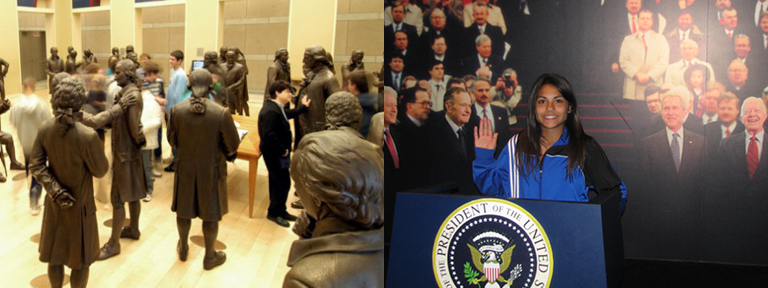
Left: Visitors and statues of “Founding Fathers” mingle seamlessly in the Signers Hall. The visitor is also a signer of the Constitution Right: A visitor participates in the “Swearing-In” ceremony to uphold the constitution of the United States.
Identity: Mission and Branding
A positive museum brand identity keeps visitors returning to your institution. At ME, we conceive exhibits as tools to build on your brand identity and foster loyalty. Our designs aim for these results because we create moments of shared identity. This is when the audience’s aspirational goals for a museum visit and the aspirational goals of a museum’s mission find common ground. In very general terms, the visitor wishes a museum visit to be educational, inspiring and a good time with friends and family. This will make them better people. The museum wishes to answer this request with a quality offering because it betters the community one visitor at a time. When this occurs, we have created value for both the visitor and the museum.
The exhibit experience is a living performance of the museum’s mission.
Case Study, Museum of Chinese in America: ME designed the exhibit Sour, Sweet, Bitter, and Spicy: Stories of Chinese Food and Identity in America. In our design the “Big-Idea” was a large banquet table for all the visitors to sit together and enjoy a visual feast of ceramics produced by two local ceramists that describe the different regional Chinese cuisines. On the walls projections show interviews of 33 chefs telling their stories in the form of oral histories. This treatment seeks to find a common ground between the visitor experience and the museum’s mission. When visitors sit together they are entering a “dialogue and understanding among people of all cultural backgrounds, bringing 160 years of Chinese American history to vivid life” — as mentioned in the MOCA’s mission statement. The exhibit experience is a living performance of the museum’s mission.
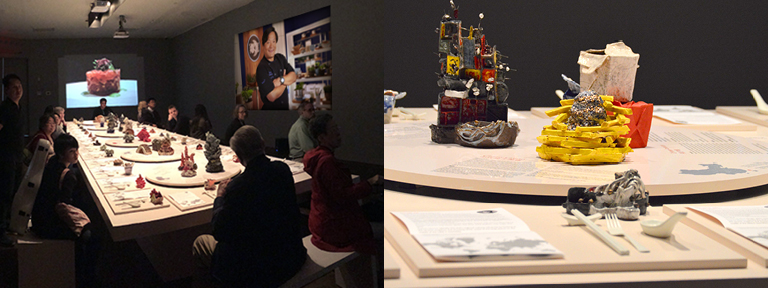
Visitor share a common table at the Museum of Chinese in America. The table is a space of “dialogue and understanding” as visitor enjoy the ceramic “feast”, and an oral history video presentation.
In summary, Museum Environments’ design process examines the interplay between Museum, Exhibits and Audience. It is the interaction where the experience happens and defines the museum visitor experience. Our goal is to stimulate engagement, build shared identities, and foster participation. We consider the best means of delivering value to our museum clients, because the design serves to connect museums and people.

